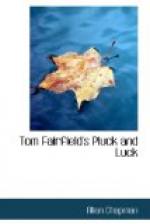“How about that, George?” asked Tom, and the small lad, who was too much engrossed with the possibility of some excitement presently to ask his usual number of questions, replied:
“I guess they’re going to stay all right. I heard Sam tell Nick to hurry up and pick out a room in Hollywood Hall, or all the best ones would be gone.”
“By Jove!” ejaculated Jack. “They mean to stay all right!”
“If we let ’em,” added Bert significantly.
“Come on,” urged Tom. “If we’re going to have a run-in with ’em, let’s have it in the open, before they get in the dormitory.”
And while our hero and his chums are thus hastening to meet the lads who had played such a mean trick on them that summer may I be permitted a few pages in which to make my new readers a little better acquainted with Tom Fairfield?
Tom, aged about sixteen, was the son of Mr. and Mrs. Brokaw Fairfield. He lived in the village of Briartown, on the Pine river, and had much sport running his motorboat on that stream.
In the first volume of this series, entitled, “Tom Fairfield’s Schooldays,” I related how Tom’s father and mother had to go to Australia to claim some property left by a relative. As it was not convenient to take Tom along he was sent to school—Elmwood Hall—where he boarded and studied.
Tom at once made friends and enemies, as any lad would. But his enemies were few, the two principal ones being Sam Heller and Nick Johnson, and they cordially hated our hero. Tom’s chief friend was Jack Fitch, with whom he roomed, though Bert Wilson, George Abbot, Joe Rooney, Lew Bentfield, Ed. Ward, Henry Miller and a host of others were on intimate terms with him. I might also mention Bruce Bennington, a Senior when Tom reached Elmwood Hall, and with whom Tom soon became friendly.
Dr. Pliny Meredith was headmaster at Elmwood. He was sometimes called “Merry” because, as Jack Fitch used to say, he was so glum. But he was a gentleman. Not so Professor Skeel, who was a taskmaster. It was against Mr. Skeel that Tom led a revolt because of the professor’s meanness in Latin class.
How the boys went on a strike, how they were made prisoners, how they escaped in a great storm, burned the effigy of Mr. Skeel at the flag pole, and how Tom won the strike—all this is set down in the first volume. There is also told how Tom saved Bruce Bennington from disgrace, and was the means of Mr. Skeel fleeing in fear of discovery.
In the second book, entitled, “Tom Fairfield at Sea,” I told how our hero learned that the vessel on which his parents were sailing from Australia had been wrecked. He at once set out to make the long voyage to try to find some news of them or, if possible, to rescue them.
The steamer on which Tom sailed was wrecked, and he and some sailors, together with a little boy, floated for some time on a derelict with which the Silver Star had collided. On the derelict, most unexpectedly, came Professor Skeel, who was on his way to Honolulu when the accident happened.




